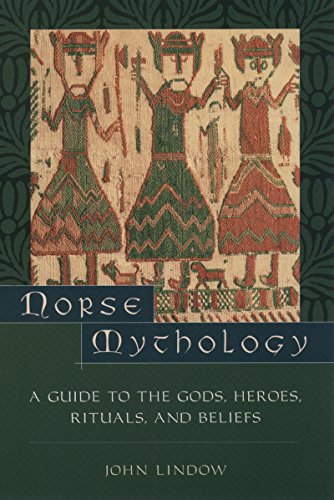Norse Mythology: A Guide to Gods, Heroes, Rituals, and Beliefs by John Lindow, ISBN-13: 978-0195153828
[PDF eBook eTextbook]
- Publisher: Oxford University Press; 1st edition (October 17, 2002)
- Language: English
- 384 pages
- ISBN-10: 0195153820
- ISBN-13: 978-0195153828
Norse Mythology explores the magical myths and legends of Norway, Sweden, Denmark, Iceland and Viking-Age Greenland and outlines the way the prehistoric tales and beliefs from these regions that have remained embedded in the imagination of the world.
The book begins with an Introduction that helps put Scandinavian mythology in place in history, followed by a chapter that explains the meaning of mythic time, and a third section that presents in-depth explanations of each mythological term. These fascinating entries identify particular deities and giants, as well as the places where they dwell and the varied and wily means by which they forge their existence and battle one another. We meet Thor, one of the most powerful gods, who specializes in killing giants using a hammer made for him by dwarfs, not to mention myriad trolls, ogres, humans and strange animals. We learn of the ongoing struggle between the gods, who create the cosmos, and the jötnar, or giants, who aim to destroy it. In the enchanted world where this mythology takes place, we encounter turbulent rivers, majestic mountains, dense forests, storms, fierce winters, eagles, ravens, salmon and snakes in a landscape closely resembling Scandinavia. Beings travel on ships and on horseback; they eat slaughtered meat and drink mead.
Spanning from the inception of the universe and the birth of human beings to the universe’s destruction and the mythic future, these sparkling tales of creation and destruction, death and rebirth, gods and heroes will entertain readers and offer insight into the relationship between Scandinavian myth, history, and culture.
Table of Contents:
Cover Page
Title Page
Copyright Page
Contents
A Note on Orthography
1 Introduction
The Historical Background
The Indo-European Background
Cult, Worship, and Sacrifice
The Importance of Scandinavian Mythology
2 Time
The Nature of Mythic Time
Mythic Past, Present, and Future
Cyclical Time
Time and Space
Myth, Narrative, and Language
Myth and History
3 Deities, Themes, and Concepts
Ægir
Ægir’s Daughters
Æsir
Æsir-Vanir War
Álfablót
Álfheim (Elf-land)
Alfödr (All-father)
Almáttki áss
Alvíssmál
Andhrímnir (Sooty-in-front)
Andlang
Andvari (Careful)
Angrboda (She-who-offers-sorrow)
Árvak and Alsvin (Early-awake and Very-swift)
Ása-Thor (Thor-of-the-æsir)
Ás-Brú (Æsir-bridge)
Ásgard (Enclosure-of-the-æsir)
Ask (Ash-tree) and Embla
Atla
Audhumla
Aurboda (Gravel-offerer)
Aurgelmir (Mud-yeller)
Aurvandil
Baldr
Baldrs Draumar (Baldr’s Dreams)
Báleyg (Flame-eye)
Barri
Baugi (Ring-shaped)
Beli
Bergbúa tháttr (The Tale of the Mountain-dweller)
Bergelmir (Bear-yeller, Mountain-yeller, or Bare-yeller)
Berserks
Bestla
Beyla
Bil and Hjúki
Bileyg (Wavering-eye)
Billing’s Girl
Bilröst
Bilskírnir
Bláin
Bölthor(n)
Bound Monster
Bous
Bracteates
Bragi
Breidablik
Brimir
Brísinga men
Brokk
Bur, Bor (Son)
Búri
Byggvir
Byleist (Byleipt, Byleift)
Dag (Day)
Dáin (Dead)
Delling
Dísablót
Dísir
Draupnir (Dripper)
Duneyr
Durathrór
Dvalin (Delayed)
Dwarfs
Eggthér
Egil
Eikinskjaldi (With-an-oaken-shield)
Eikthyrnir (Oak-encircler)
Ein(d)ridi (Lone-rider)
Einherjar (Lone-fighters)
Eir
Eiríksmál
Eistla
Eitri
Eldhrímnir (Fire-sooty)
Eldir
Élivágar (Hailstorm-waves)
Elli (Old-age)
Elves
Eyrgjafa
Falhófnir (Pale-hoofed)
Fárbauti (Anger-striker)
Fenrir
Fensalir (Bog-halls)
Fimafeng
Fimbul-
Fjalar (Deceiver)
Fjölnir
Fjölvar
Fjörgyn
Fólkvang (People-field or Army-field)
Fornjót
Forseti (Chairman)
Freki (Ravenous-one)
Frey
Freyja (Lady)
Frigg
Fródi
Fulla
Galdrar
Game of the Gods
Garm
Gefjon
Gefn
Geirröd
Gerd
Geri (Ravenous-one)
Gestumblindi (One-blind-to-guests?)
Gimlé
Ginnunga Gap
Gísl
Gjallarbrú
Gjallarhorn (Screaming-horn)
Gjálp
Glad (Glad)
Gladsheim
Glær (Glassy)
Gleipnir
Glen
Glitnir
Gná
Gnipahellir (Gnipa-cave)
Gods, Words for
Greip (Grip)
Gríd
Grímnismál
Grottasöng
Gullinborsti (Gold-bristle)
Gullintanni (Gilded-tooth)
Gulltopp (Gold-top)
Gullveig
Gungnir
Gunnlöd
Gyllir
Gymir
Hábrók (High-pants)
Haddingjar
Hadingus
Hákonarmál
Háleygjatal
Hallinskídi
Hárbardsljód
Harthgrepa (Hard-grip)
Hati Hródvitnisson
Hávamál
Heid
Heidrún
Heimdall
Hel
Hermód
Hildisvíni (Battle-pig)
Himinbjörg (Heaven-mountain)
Hjadningavíg (Battle-of-the-followers-of-Hedin)
Hlidskjálf
Hlín
Hlóra
Hlórridi
Hnoss (Treasure)
Höd
Hoddmímir’s Forest
Hœnir
Hörn
Hræsvelg
Hraudung
Hrímfaxi
Hrímgrímnir (Frost-masked)
Hringhorni (Ring-horn)
Hródvitnir
Hropt
Hrungnir
Hugin (Thought) and Munin (Mind)
Hvedrung
Hvergelmir (Hot-spring-boiler)
Hymir
Hymiskvida
Hyndluljód
Hyrrokkin (Fire-smoked)
Idavöll
Idun
Ifing
Ing
Ingunar-Frey
Interpretatio Germanica
Interpretatio Romana
Járnsaxa (Armed-with-an-iron-sword)
Járnvid (Iron-woods)
Jörd (Earth)
Jötunheimar (Giant-worlds)
Kvasir
Lærad
Laufey
Léttfeti (Light-foot)
Líf and Lífthrasir
Lit (Color, Countenance)
Ljódatal
Loddfáfnismál
Lódur
Lofn
Logi (Fire)
Lokasenna
Loki
Lopt
Magni (The Strong)
Mánagarm (Moon-dog)
Máni (Moon)
Mannus (Man)
Mardöll
Matres and Matrones
Mead of Poetry
Meili
Merseburg Charms
Midgard (Central-enclosure)
Midgard Serpent
Mímir (Mím, Mími)
Módgud (Battle-weary)
Módi (Angry-one)
Mundilfœri
Muspell
Naglfar
Naglfari
Nál (Needle)
Nanna
Nari and/or Narfi
Nerthus
Nidafjöll
Nidavellir
Nídhögg (Evil-blow)
Niflheim (Fog-world) and Niflhel (Fog-Hel)
Njörd
Norns
Nótt (Night)
Ód
Odin (Old Norse Óðinn)
Ódrerir
Ögmundar tháttr dytts ok Gunnars Helmings (The Tale of Ögmund Dint and Gunnar Half)
Ragnarök (Judgment-of-the-powers)
Rán
Ratatosk (Bore-tooth)
Regnator Omnium Deus
Rígsthula
Rind
Röskva (Ripe?)
Sæhrímnir
Sæming
Sága
Seid
Sif (In-law-relationship)
Sigyn
Sindri (Slag)
Sjöfn
Skadi
Skídbladnir
Skínfaxi (Shining-mane)
Sköll
Skrýmir (Big-looking)
Sleipnir
Slídrugtanni (Dangerous-tooth)
Snotra
Sól (Sun)
Sörla tháttr
Starkad
Surt
Suttung
Syn
Sýr (Sow)
Thjálfi
Thjazi
Thor
Thrúd (Strength)
Thrúdgelmir (Strength-yeller)
Thrúdheim (Strength-world)
Thrúdvangar (Strength-fields)
Thrymheim (Din-world)
Thrymskvida (The Poem of Thrym)
Tuisto
Týr
Ull
Urdarbrunn (Well-of-Urd)
Útgard (Outer-enclosure)
Útgarda-Loki (Loki-of-the-Útgards)
Vafthrúdnismál
Válaskjálf
Valhöll (Carrion-hall)
Váli, Son of Loki
Váli, Son of Odin
Vanir
Vár
Vedrfölnir (Storm-pale)
Vídar
Vídbláin (Wide-blued)
Vídblindi (Wide-blind)
Vidfinn (Wood-Finn)
Vili and Vé
Vingólf (Friend-hall)
Völund
Völuspá
Vör
Yggdrasil (Ygg’s-steed)
Ymir
Yngvi
4 Print and Nonprint Resources
Background—Viking and Medieval Scandinavia
Archaeology
Etymology
The Conversion of Iceland
Medieval Iceland
Women and Gender
Encyclopedias
Primary Sources—Translations
Primary Sources—Commentary and Analysis
Eddic and Skaldic Poetry
Snorri Sturluson
Literary Histories
Mythology: General Treatments
Mythology: Important Studies
Nonprint Resources
Index
John Lindow is a professor at the University of California, Berkeley specializing in Scandinavian medieval studies and folklore.
What makes us different?
• Instant Download
• Always Competitive Pricing
• 100% Privacy
• FREE Sample Available
• 24-7 LIVE Customer Support






Reviews
There are no reviews yet.